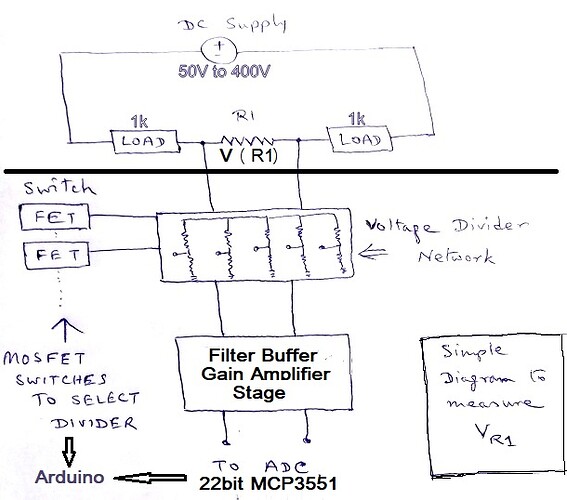jremington:
Nope.
The more interesting issue is the effect of applying 50-400 V across a sample with resistance in the micro/milliOhm range. Take a moment to ponder the current that will pass through it. Hint: use Ohm's Law.
There is load on both side of the resistor, please see the diagram.
JohnRob:
Perhaps I'm missing something but the schematic shows 2 1k resistors in the loop. Meaning at 400V the current would be ~ 200 ma. And each 1K will dissipate 40 watts.
My question is the OP might do better if they defined the basic goal (accuracy sample range etc).
My guess is the sample current would be "known" if the power supply voltage were known. However resistors capable of dissipating 40 watts are not likely to be terribly stable.
Issues I see are:
-
Getting meaningful data from the 2 lsb's of the 22 bit daq is near impossible. Even with long integration time.
-
When measuring µV one must be careful of the materials being uses else a termocouple will be formed causing temperature related error.
Jon
Thanks for your reply Jon. And thanks for noticing the loads on the diagram, unlike others. Just consider the loads and other things above the Black line as fixed in a particular scene, but the supply and loads can change form test to test.
That is why I want to measure V across R1, and current in the loop at the same time to find out R1. I need to design the measurement part that can accurately measure the drop across R1. If you need a range for R1, it will be 10^-5 to 2 Ohm. Accuracy that I am looking for is <1%.
I am aware of the issues you have mentioned. I am trying to use good ppm/C resistors and will take care in pcb designing and soldering as well. Lets just start with something first.
outofoptions:
He had another thread. He wants to measure the resistance of a conductor under load. He was talking about measuring nanovolts. All the added 'stuff' just adds more error.
But Ohm's law. You can measure voltage and current to get the resistance. Can he build a volt meter that will accurately read in the nanovolts at 400VDC and read it with an Arduino? Does he have a current source that is that accurate? I have my doubts.
I actually hijacked that thread instead of posting my own - i don't need the nano volt measurement, micro will just do. And I don't think I need an accurate current source, I can use a good Vref for the ADC, and when finding R1 =I*R1/I = VR1/I , I gets cancelled out?
Grumpy_Mike:
No doubts here, he can't.
Of course I can't, at-least not without help. And that is why I have posted the problem here.
Edit: To make it simple, This is just like a micro-ohm meter, but without any constant current source. We need to determine the current on the spot as well as the voltage drop to determine the R1. I can easily determine the current with <1% accuracy. So in this post I am only focusing on measuring VR1. I hope I have made my query clear enough. Thanks for looking into it.


